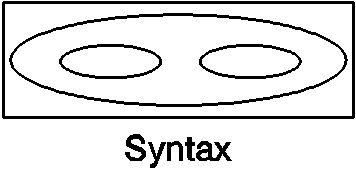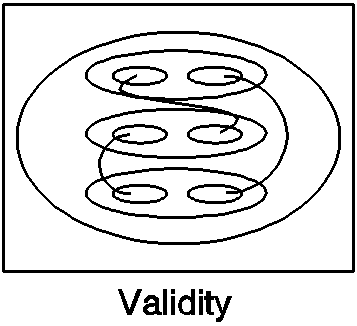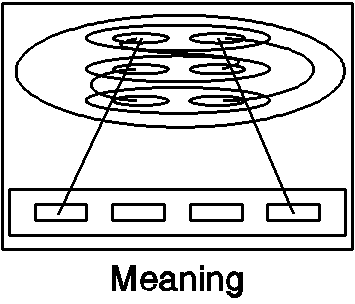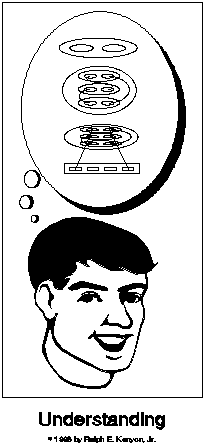Levels or perspectives on the use of language.
APR 01, 1997
© Copyright 1997 by Ralph E. Kenyon, Jr.
Diagrams © copyright 1993, by Ralph Kenyon
I often answer the question "What is general semantics?" by placing
it in a context with other perspectives on the use of language. I describe
four perspectives or levels ordered by increasing complexity. These levels
are (1) grammar, (2) logic, (3) semantics, and (4) general semantics. I
use a modified outline similar to that presented by Bob Pula at Institute
seminars. Bob abstracted his material from Anatol Rappaport.
In the time since I was first exposed to these ideas, my understanding has
matured, and in 1993 I developed some visual imagery to accompany the textual
material. In what follows, my terse description of each level is accompanied by
an illustration of the structure, as I see it, of the notions being
presented. I include Anatol Rappaport's original text as well as Bob
Pula's abstraction, and I include some additional discussion. At
level 4, the description of the general semantics perspective, I differ somewhat
because I have found succinct descriptions that can be expressed by a structure
that is more parallel to the first three levels. My extrapolation provides
parallelism through all four levels. Here, then, are four separate
descriptions together with a visual image of structure for each of the four
levels.
1. Grammar Relations - words to words in sentences.
Grammar deals only with word-to-word relations. It teaches how to put words
together into a sentence. It is not interested in how sentences are
related to each other or how they are related to facts.(1)
-- grammar: word to word relationships (structure)
basic unit: sentence(2)
 For the
grammarian, a sentence has a structure with parts (words) related to each other
by a certain order. Different parts, for example, subject and predicate,
are identified by some method and exist in some relation to each other.
For example, in 'Socrates is mortal.', 'Socrates' is the subject and 'is mortal'
is the predicate.
For the
grammarian, a sentence has a structure with parts (words) related to each other
by a certain order. Different parts, for example, subject and predicate,
are identified by some method and exist in some relation to each other.
For example, in 'Socrates is mortal.', 'Socrates' is the subject and 'is mortal'
is the predicate.
2. Logic Relations - subjects and predicates in arguments.
Logic goes further. To a logician, sentences are assertions, and he
is interested in relations between assertions (if this is true, then that is
true). But for the logician words need not have any meaning except as
defined by other words, and the assertions need not have any relation to the
world of fact. (1)
-- logic: statement to statement relationships (structure)
basic unit: paragraph(2)
 For the
logician, an argument (paragraph) has a structure with (premises and conclusion)
propositions (sentences) related to each other by a certain order. Each
proposition sentence consists of a subject term and a predicate term. A
subject term in one premise (sentence) must also be a predicate term in at least
one other premise. The relationship between these parts in the argument
(paragraph) as a whole determines whether the argument is "valid".
Consider a classic syllogism for example:
For the
logician, an argument (paragraph) has a structure with (premises and conclusion)
propositions (sentences) related to each other by a certain order. Each
proposition sentence consists of a subject term and a predicate term. A
subject term in one premise (sentence) must also be a predicate term in at least
one other premise. The relationship between these parts in the argument
(paragraph) as a whole determines whether the argument is "valid".
Consider a classic syllogism for example:
| All men are mortal. |
Major premise |
| Socrates is a man. |
Minor premise |
| Socrates is mortal. |
Conclusion |
The logician uses the structure the grammarian is interested in, but he puts
more sentences together into a paragraph and adds his own structure to the
paragraph.
3. Semantics Relations - words to referents in indications.
The semanticist goes further than the logician. To him words and
assertions have meaning only if they are related operationally to
referents. The semanticist defines not only validity (as the logician
does) but also truth. (1)
-- semantics: word/statement to referent relationships (structures)
straddles the verbal/non-verbal domains; these relationships usually
formulated in formal-technical, often mathematical, language(2)
 For
the semanticist, grammar and logic, sentences and arguments, are all very
interesting, but he is more interested in how these words function so that
people can talk about things; he is interested in what words and sentences refer
to. The semanticist wants to see something non-verbal, even if only a
drawing, that the words refer to. Much more discussion of this point
really isn't necessary because I can't hold something up for you to see or
feel. I can perhaps refer with these words to your non-verbal touch
sensations and visual sensations as you hold and read this paper (or browse with
the keyboard and look at the computer screen), but I can't say the experiences
themselves. We might say that the semanticists is chiefly concerned with
how words are used to refer to things.
For
the semanticist, grammar and logic, sentences and arguments, are all very
interesting, but he is more interested in how these words function so that
people can talk about things; he is interested in what words and sentences refer
to. The semanticist wants to see something non-verbal, even if only a
drawing, that the words refer to. Much more discussion of this point
really isn't necessary because I can't hold something up for you to see or
feel. I can perhaps refer with these words to your non-verbal touch
sensations and visual sensations as you hold and read this paper (or browse with
the keyboard and look at the computer screen), but I can't say the experiences
themselves. We might say that the semanticists is chiefly concerned with
how words are used to refer to things.
4. General Semantic Relations - semantic reactions to events in time-binding.
Semantic reactions - grammar, logic, and semantics - of nervous systems while
making and using cognitive maps.
The general semanticist goes the furthest. He deals not only with words,
assertions, and their referents in nature but also with their effects on human
behavior. For a general semanticist, communication is not merely words in
proper order properly inflected (as for the grammarian) or assertions in
proper relation each other (as for the logician) or assertions in proper
relation to referent (as for the semanticist), but all these together, with
the chain of "fact to nervous system to language to nervous system to
action".(1)
-- general-semantics: Language-nervous system
(organism-as-a-whole-non-verbal levels-human behavior relationships (again,
structures) (2)
Each discipline listed above incorporates the concerns of its predecessor
(as listed).(2)
The general semanticist talks about how people in general
and individuals in particular react or respond to words, arguments,
things, other people, events, etc, in terms of making sense of their
experiences (semantic reactions). The general semanticist is
concerned with his present theory that people construct their
understanding (which he calls maps) of their experiences (which he calls
territories) through a process which includes abstracting, assuming, and
corroboration or disconfirmation and how awareness of this process (consciousness of
abstracting) can be
used to increase its effectiveness.
In addition, the general semanticist emphasizes the symbolic and
linguistic activities of mankind as a species, particularly in
communicating through time using language.
Thus, Korzybski's principles have a close relation to semantic
principles. It follows that the whole Korzybskian system is an
outgrowth of semantics. But the korzybskian system goes much
further. When its implications are worked out, it will be as far
removed from semantics as semantics is from logic, and as logic is from
grammar. (1)
|
 |
In summary, we looked at four perspectives on the use of language.
| level |
perspective |
objects |
evaluation |
basic unit |
| 1 |
grammar |
words |
syntax |
sentence |
| 2 |
logic |
propositions |
validity |
argument |
| 3 |
semantics |
word and referent |
functionality |
indication |
| 4 |
general semantics |
semantic reactions |
effectiveness |
cognitive mapping |
The grammarian interests himself in the syntax of relations among words in
the basic unit of a sentence. In addition, the logician interests himself
in the validity of relations among sentences (subjects and predicates) of
propositions in the
basic unit of a paragraph. Beyond these, the semanticist interests
himself in the functional meaning of relations among words and sentences and
their referents in the basic unit of performing indications. Further more,
the general semanticist interests himself in the effectiveness relations among
semantic reactions in the basic unit of making and using cognitive maps in
dealing with life situations, particularly those involving inter- and
intra-personal symbolic communicating.
References
- Anatol Rapaport, What Is Semantics? in The Use and Misuse of Language,
edited by S. I. Hayakawa, Fawcett Publications, Greenwich, Connecticut,
(1962) (back)
- Bob Pula, "Four Selected Ways to Examine Language", from his
"Notes from an Institute of General Semantics Summer
Seminar-Workshop". (back)
Annotated bibliography of general semantics papers
General Semantics and Related Topics
| This page was updated by Ralph Kenyon on
2009/11/16 at 00:27
and has been accessed
36404
times at
63
hits per month.
|
|---|
 For the
grammarian, a sentence has a structure with parts (words) related to each other
by a certain order. Different parts, for example, subject and predicate,
are identified by some method and exist in some relation to each other.
For example, in 'Socrates is mortal.', 'Socrates' is the subject and 'is mortal'
is the predicate.
For the
grammarian, a sentence has a structure with parts (words) related to each other
by a certain order. Different parts, for example, subject and predicate,
are identified by some method and exist in some relation to each other.
For example, in 'Socrates is mortal.', 'Socrates' is the subject and 'is mortal'
is the predicate. For the
logician, an argument (paragraph) has a structure with (premises and conclusion)
propositions (sentences) related to each other by a certain order. Each
proposition sentence consists of a subject term and a predicate term. A
subject term in one premise (sentence) must also be a predicate term in at least
one other premise. The relationship between these parts in the argument
(paragraph) as a whole determines whether the argument is "valid".
Consider a classic syllogism for example:
For the
logician, an argument (paragraph) has a structure with (premises and conclusion)
propositions (sentences) related to each other by a certain order. Each
proposition sentence consists of a subject term and a predicate term. A
subject term in one premise (sentence) must also be a predicate term in at least
one other premise. The relationship between these parts in the argument
(paragraph) as a whole determines whether the argument is "valid".
Consider a classic syllogism for example: For
the semanticist, grammar and logic, sentences and arguments, are all very
interesting, but he is more interested in how these words function so that
people can talk about things; he is interested in what words and sentences refer
to. The semanticist wants to see something non-verbal, even if only a
drawing, that the words refer to. Much more discussion of this point
really isn't necessary because I can't hold something up for you to see or
feel. I can perhaps refer with these words to your non-verbal touch
sensations and visual sensations as you hold and read this paper (or browse with
the keyboard and look at the computer screen), but I can't say the experiences
themselves. We might say that the semanticists is chiefly concerned with
how words are used to refer to things.
For
the semanticist, grammar and logic, sentences and arguments, are all very
interesting, but he is more interested in how these words function so that
people can talk about things; he is interested in what words and sentences refer
to. The semanticist wants to see something non-verbal, even if only a
drawing, that the words refer to. Much more discussion of this point
really isn't necessary because I can't hold something up for you to see or
feel. I can perhaps refer with these words to your non-verbal touch
sensations and visual sensations as you hold and read this paper (or browse with
the keyboard and look at the computer screen), but I can't say the experiences
themselves. We might say that the semanticists is chiefly concerned with
how words are used to refer to things.